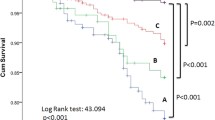Abstract
Background
Whereas the creatinine generation rate may reflect only the protein nutritional status by way of muscle mass, the predialysis serum albumin concentration may well reflect a variety of aspects of a patient's pathophysiologic status, including the protein nutritional status. The aim of this study was to clarify whether or not serum albumin concentration and the creatinine generation rate reflect the same pathophysiologic status.
Methods
The risk of death associated with the creatinine generation rate was studied with and without adjustment for the serum albumin concentration in 1588 patients undergoing hemodialysis. A comparison was also made between the death risk associated with serum albumin concentrations with and without adjustment for the creatinine generation rate. Possible correlations between the creatinine generation rate and serum albumin concentration were evaluated.
Results
The death risk associated with the creatinine generation rate was little changed when adjusted for serum albumin concentration. However, the death risk associated with serum albumin concentration remained high even after being adjusted by the creatinine generation rate. Moreover, the correlation was very weak between the creatinine generation rate and the serum albumin concentration.
Conclusions
Serum albumin concentration and the creatinine generation rate do not reflect the same pathophysiologic status.
Similar content being viewed by others
References
Lowrie EG, Lew NL, Huang WH. Race and diabetes as death risk predictors in hemodialysis patients. Kidney Int 1992;42(suppl 38):S22-S31.
Weiss Ch, Jelkmann W. 18.2 blood plasma, In: Schmidt RF, Thews G (eds) Human physiology. Berlin and Heidelberg: Springer Verlag; 1989:405–411.
Shinzato T, Nakai S, Miwa M, Takai I, Matsumoto Y, Morita H, Maeda K. New method to calculate creatinine generation rate using pre- and post-dialysis creatinine concentrations. Artif Organs 1997;21(8):864–872.
Doumas BT, Watson WA, Biggs HG. Albumin standards and the measurement of serum albumin with bromcresol green. Clin Chim Acta 1971;31:87–96.
SAS Institute Inc. The Logist Procedure: in SAS/STAT User's Guide, Version 6, 4th ed. Vol. 2. Cary, NC, SAS Institute, 1989:1071–1126.
Crockcroft DW, Gault MH. Prediction of creatinine clearance from serum creatinine. Nephron 1976;16:31–41.
SAS Institute Inc. The Corr procedure. In: SAS procedure reference guide, release 6.03 Ed. Cary, NC: SAS Institute, 1990:107–136.
Registration Committee of the Japanese Society for Dialysis Therapy. An overview of regular dialysis treatment in Japan (as of Dec. 31, 1996), Tokyo: Japanese Society for Dialysis Therapy, Tokyo, 1997:122.
Author information
Authors and Affiliations
About this article
Cite this article
Nakai, S., Shinzato, T., Miwa, M. et al. Predialysis serum albumin concentration and creatinine generation rate do not reflect the same pathophysiologic status. Clin Exper Neph 2, 44–49 (1998). https://doi.org/10.1007/BF02480623
Received:
Revised:
Accepted:
Published:
Issue Date:
DOI: https://doi.org/10.1007/BF02480623




